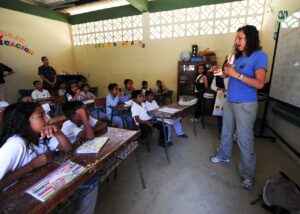Philippine Education at a Crossroads: Challenges, Opportunities
The Philippine government continues to strive toward empowering its citizens through education reforms, but various issues—both global and local—continue to shape its trajectory.

Wikimedia Creative Commons
The education system in the Philippines, like many others, faces a complex interplay of challenges and opportunities. From enrollment trends and literacy rates to global competitiveness and local limitations, education remains a cornerstone of the country’s development.
The Philippine government continues to strive toward empowering its citizens through education reforms, but various issues—both global and local—continue to shape its trajectory.
It becomes clear that while the Philippines is making strides by examining education statistics, enrollment trends, literacy rates, and challenges, significant efforts are still required to fully realize the potential of its education system.
Enrollment Trends and Access to Education
Over the past few decades, the Philippines has made substantial progress in increasing access to education. The implementation of the K-12 system in 2013 expanded the basic education curriculum, aligning the country with international standards.
According to the Department of Education (DepEd), in 2022, the country had 28.4 million students enrolled in basic education, with 2.3 million in Senior High School (DepEd). The number represented a gradual increase compared to previous years, indicating a growing awareness of the value of education.
However, challenges remain, particularly in terms of reaching marginalized communities.
A 2021 report by the Philippine Statistics Authority (PSA) revealed that while enrollment in basic education increased, participation in Senior High School remains uneven, particularly in rural and conflict-affected areas (PSA).
The disparity in enrollment figures reflects the socio-economic and geographical divide, where children from poor, remote areas are less likely to continue their education beyond elementary school.
Literacy Rates and Educational Outcomes
The Philippines has long prided itself on relatively high literacy rates, with the 2020 census reporting an overall literacy rate of 96.5% (PSA).
However, functional literacy—which encompasses reading comprehension and practical skills—reveals a more concerning picture.
The Southeast Asia Primary Learning Metrics (SEA-PLM) report in 2019 shows that many Filipino students lag behind their peers in the region, particularly in reading and mathematics (SEA-PLM). The report suggests that while basic literacy is widespread, the quality of education and the development of critical thinking and problem-solving skills need improvement.
The results of the 2018 Programme for International Student Assessment (PISA) further underscore this issue. The Philippines ranked lowest among 79 countries in reading comprehension and second to the lowest in science and mathematics (OECD).
PISA results have sparked widespread concern about the quality of education, highlighting the need for reforms that go beyond access and focus on improving teaching methodologies, curriculum design, and teacher training.
Global and Local Challenges
The challenges facing Philippine education are not isolated.
Globally, education systems are grappling with disruptions caused by the COVID-19 pandemic.
In the Philippines, the pandemic exacerbated existing inequalities. A shift to online and modular learning left many students, particularly those from low-income families, without access to reliable internet or digital devices.
A 2021 report by the Asian Development Bank (ADB) revealed that 41% of students lacked access to necessary technology for distance learning (ADB). The digital divide has widened the gap between urban and rural students, with long-term consequences for education quality and outcomes.
Locally, the challenges are also rooted in systemic issues such as inadequate funding and infrastructure.
DepEd reported in 2022 that many public schools remain overcrowded, with a classroom-to-student ratio far exceeding the ideal (DepEd). Additionally, the shortage of qualified teachers, especially in specialized subjects like science and mathematics, continues to undermine efforts to improve educational quality.
Another local challenge is the mismatch between education and employment.
The Philippines has seen high unemployment rates among college graduates, revealing a disconnect between the skills taught in schools and the demands of the labor market.
The Philippine Institute for Development Studies (PIDS) in a study found that many graduates lack the soft skills and technical expertise needed in growing industries, such as information technology and engineering (PIDS).
The situation suggests that the education system needs to pivot toward a more skills-based and industry-relevant curriculum to better prepare students for the workforce.
Opportunities for Reform and Development
Despite these challenges, the Philippines is committed to improving its education system.
The government has shown a strong willingness to enact reforms, such as the introduction of the Universal Access to Quality Tertiary Education Act in 2017, which offers free tuition to students in state universities and colleges (CHED). The legislation marked a significant step toward making higher education more accessible to underprivileged students.
Moreover, efforts to integrate technology into education, especially in light of the pandemic, have opened new opportunities for learning innovation.
The Department of Education has initiated partnerships with tech companies and international organizations to expand digital literacy and online learning resources (DepEd). These initiatives, if sustained, could help close the digital divide and offer more flexible, accessible learning options for students across the country.
The commitment to early childhood education is another area of promise.
Studies have shown that early investment in education yields significant long-term benefits.
The Philippine government has increased funding for Early Childhood Care and Development (ECCD) programs, recognizing that a strong foundation in early years education is crucial for lifelong learning and success (PIDS). Expanding these programs, particularly in underserved areas, could improve educational outcomes and increase future employment opportunities for Filipino youth.
Conclusion
The Philippine education system is at a critical juncture, balancing between significant challenges and promising opportunities.
Indeed, the country has made considerable progress in increasing access to education and maintaining high literacy rates. In the same breath, issues related to quality, equity, and relevance to the job market persist.
The government’s ongoing commitment to reform, combined with initiatives to improve teacher training, integrate technology, and invest in early education, offers hope for a brighter future.
However, realizing these opportunities requires sustained political will, adequate funding, and collaboration between public and private sectors to ensure that education truly empowers every Filipino citizen.
Works Cited
Asian Development Bank (ADB). COVID-19 and Education in Asia and the Pacific: Guidance Note. ADB, 2021.
Department of Education (DepEd). 2022 Basic Education Enrollment Figures. DepEd, 2022.
Organisation for Economic Co-operation and Development (OECD). PISA 2018 Results (Volume I): What Students Know and Can Do. OECD Publishing, 2019.
Philippine Institute for Development Studies (PIDS). Mismatch Between Education and Employment: Addressing the Skills Gap. PIDS, 2020.
Philippine Statistics Authority (PSA). Functional Literacy, Education, and Mass Media Survey (FLEMMS) 2020. PSA, 2021.
Southeast Asia Primary Learning Metrics (SEA-PLM). SEA-PLM 2019 Regional Report on Education Results. United Nations Children’s Fund (UNICEF), 2020.








